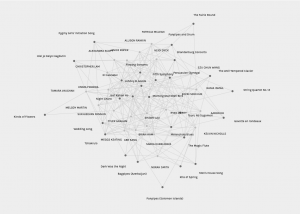Network Assignment Using Golden Record Curation Quiz Data
Palladio provides an interesting look at visualizing data. The ability to customize the visualization also provides more insight and variety into the data set. Even with these customizable features, interpreting a set of data that is not grounded in any intention “lacks” an abundance of information.
In the original assignment, Assignment #8, we were asked to curate the “Golden Record”, a record of 27 songs that represent the world of music, down to 10 songs based on our own criteria. This assignment intrigued me from the start because I knew that my own interpretation of the assignment and the music was going to be a lot different from everyone else’s interpretation. For instance, I decided to focus only on the instrumental selections provided in the Golden Record, and then pare that list down even further by selecting songs that represent the variety of the world’s instruments. Instead of focusing on instrumentals, another colleague may have selected songs that were only vocal, or maybe someone decided on their final curated list by selecting songs that they just liked. There was a wide range of interpretation left based on the description of the assignment and this led to a wide variety of data.
When I was reflecting on the Palladio data and Assignment #8, I immediately started thinking about Top 40 music. Top 40 music was something that I was exposed to in my household growing up, and I imagine it was commonplace in a lot of other households as well. By selecting some of the options in Palladio, it is possible to see which songs were the “most popular” amongst the participants, and which songs were the “least popular” amongst the participants. What defines “popular” here is part of the issue interpreting this data. This really got me thinking about music, as a cultural and artistic expression, and how one song can be grouped higher than another song, or how one song can make the Top 40, when another song does not. What made one song in our Palladio data more “popular” than another song? This is one question that I feel is not able to be answered based on the data set that was generated for this assignment. In the selection of the songs, we were not required to enter a “reason” for our selection into the Palladio data set. So even though some songs may have more “hits” in Palladio than another song, it is completely unknown why each participant chose this song over another song.

The “missing data” that leaves the viewer room for interpretation brings about political implications with this data set. Someone viewing this data may be automatically drawn to which songs were “popular”, which songs were misses, and all of the inbetween. But, here we are missing the knowledge of “why.” Through this knowledge of “why”, we might learn about the values and biases that went into the song selections, which would make for a more authentic interpretation of the data. The “why” is what I craved, no matter what selections I made in Palladio to change the visualization of the data.
